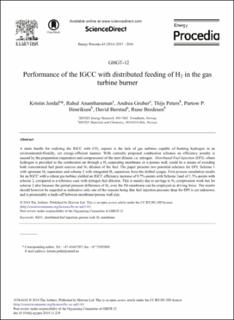| dc.contributor.author | Jordal, Kristin | |
| dc.contributor.author | Anantharaman, Rahul | |
| dc.contributor.author | Gruber, Andrea | |
| dc.contributor.author | Peters, Thijs | |
| dc.contributor.author | Henriksen, Partow Pakdel | |
| dc.contributor.author | Berstad, David Olsson | |
| dc.contributor.author | Bredesen, Rune | |
| dc.date.accessioned | 2020-04-16T08:39:43Z | |
| dc.date.available | 2020-04-16T08:39:43Z | |
| dc.date.created | 2015-01-05T10:40:52Z | |
| dc.date.issued | 2014 | |
| dc.identifier.citation | Energy Procedia. 2014, 63 2037-2044. | en_US |
| dc.identifier.issn | 1876-6102 | |
| dc.identifier.uri | https://hdl.handle.net/11250/2651247 | |
| dc.description.abstract | A main hurdle for realizing the IGCC with CO2 capture is the lack of gas turbines capable of burning hydrogen in an environmental-friendly, yet energy-efficient manner. With currently proposed combustion schemes an efficiency penalty is caused by the preparation (separation and compression) of the inert diluent, i.e. nitrogen. Distributed Fuel Injection (DFI), where hydrogen is provided to the combustion air through a H2-separating membrane or a porous wall, could be a means of avoiding both concentrated fuel point sources and N2 dilution of the fuel. The paper presents two potential schemes for DFI: Scheme 1 with upstream H2 separation and scheme 2 with integrated H2 separation from the shifted syngas. First process simulation results for an IGCC with a reheat gas turbine yielded an IGCC efficiency increase of 0.7%-points with Scheme 1 and of 1.3%-points with scheme 2, compared to a reference case with nitrogen fuel dilution. This is mainly due to savings in N2 compression work but for scheme 2 also because the partial pressure difference of H2 over the Pd membrane can be employed as driving force. The results should however be regarded as indicative only one of the reasons being that fuel injection pressure drop for DFI is yet unknown, and is presumably a trade-off between membrane/porous wall size. | en_US |
| dc.language.iso | eng | en_US |
| dc.rights | Attribution-NonCommercial-NoDerivatives 4.0 Internasjonal | * |
| dc.rights.uri | http://creativecommons.org/licenses/by-nc-nd/4.0/deed.no | * |
| dc.subject | IGCC | en_US |
| dc.subject | Distributed fuel injection | en_US |
| dc.subject | Porous wall | en_US |
| dc.subject | H2 membrane | en_US |
| dc.title | GHGT-12 Performance of the IGCC with distributed feeding of H2 in the gas turbine burner | en_US |
| dc.type | Peer reviewed | en_US |
| dc.type | Journal article | en_US |
| dc.description.version | publishedVersion | en_US |
| dc.rights.holder | The Authors | en_US |
| dc.source.pagenumber | 2037-2044 | en_US |
| dc.source.volume | 63 | en_US |
| dc.source.journal | Energy Procedia | en_US |
| dc.identifier.doi | 10.1016/j.egypro.2014.11.219 | |
| dc.identifier.cristin | 1190286 | |
| dc.relation.project | Norges forskningsråd: 193816 | en_US |
| cristin.unitcode | 7548,60,0,0 | |
| cristin.unitcode | 7548,70,0,0 | |
| cristin.unitcode | 7401,80,3,2 | |
| cristin.unitcode | 7401,80,3,0 | |
| cristin.unitname | Gassteknologi | |
| cristin.unitname | Termisk energi | |
| cristin.unitname | Tynnfilm og membranteknologi | |
| cristin.unitname | Bærekraftig energiteknologi | |
| cristin.ispublished | true | |
| cristin.fulltext | original | |
| cristin.qualitycode | 1 | |

